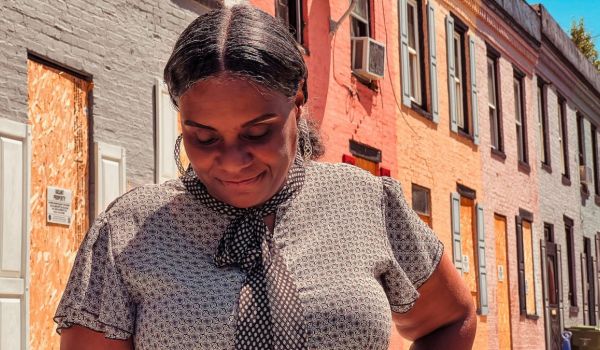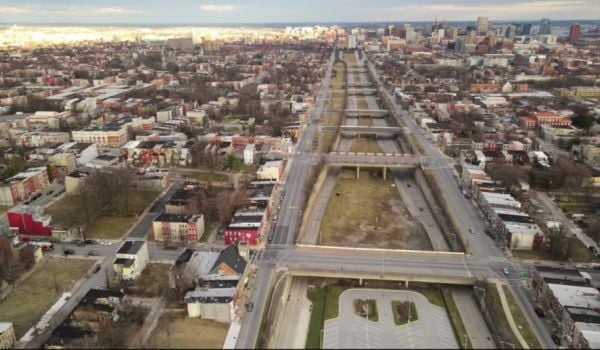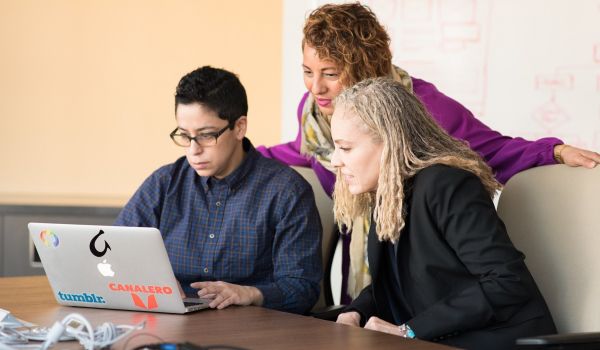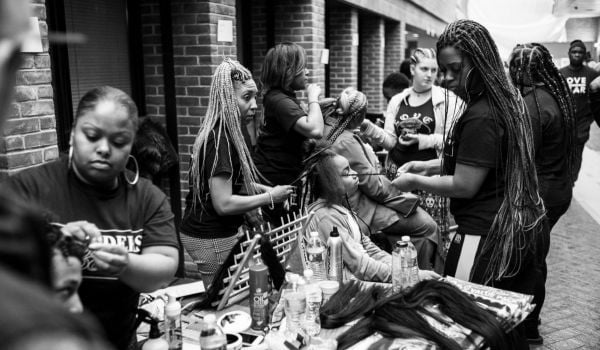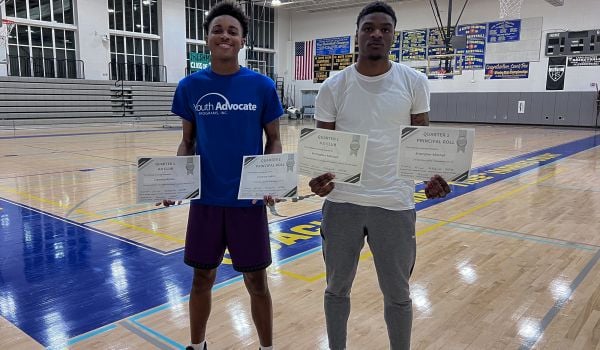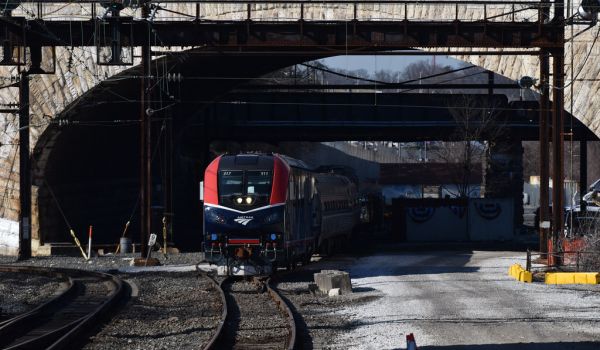Driving south on Broadway, there is a point at which East Baltimore becomes a construction site. For the past five years, several blocks surrounding Johns Hopkins Hospital have been occupied by bulldozers, cranes, rubble and construction tape. This is the $1.8 billion redevelopment project known as the Johns Hopkins Biotech Park, and for many it represents the city of Baltimore’s brightest hope for reinvigorating its shrinking post-industrial economy and combating poverty and unemployment.
The plan for pristine new labs, office buildings, mixed-income housing and green space is a collaboration between Johns Hopkins Hospital, the state of Maryland, Baltimore City, the Annie E. Casey Foundation and a Cleveland-based real estate developer, Forest City Enterprises. Maryland and Baltimore City will invest $26.5 million and $173.5 million to the project respectively, primarily funding demolition and infrastructure. Planners expect it to deliver thousands of new jobs and over a billion dollars in revenue to a neighborhood known as Middle East.
Once a healthy working-class community, Middle East has suffered from decades of disinvestment resulting in poverty, drugs, and violence. The East Baltimore Development Inc, the non-profit entity facilitating the project’s public-private partnership, has initiated a plan to raze the entire neighborhood, relocate its current residents through the city’s use of eminent domain, and replace existing homes with 2,400 units of mixed income housing, including subsidized, mid-priced, and market-rate facilities. There is even talk of placing an Amtrak stop in the new development, with hopes of attracting Washington DC commuters, because what self-respecting DC professional wouldn’t want to live in a neighborhood called Middle East?
In a recent New York Times article covering the project, Scott Levitan, senior vice president of Forest City, shares his idealistic aspiration: “Hopefully, this is the last time we’ll have to demolish a neighborhood in order to save it.” Though certainly noble, the comment ignores the reality of urban development practices in cities around the country. Barely a three-hour drive from the construction zone of Middle East, the Forest City Enterprise affiliate, Forest City Ratner Companies is clearing a 22-acre swath of downtown Brooklyn for another publicly-funded attempt at mixed-income development, this one including a Frank Gehry-designed basketball arena rather than biotech labs.
For the sake of argument, let’s dismiss any suspicion that Mr. Levitan is enticed by the prospect of copious returns and we’ll take his comment at face value; let’s assume that Mr. Levitan’s primary motivation in spearheading East Baltimore’s redevelopment project is an altruistic desire to “create a new model of inclusive city rebuilding” and revitalize a blighted neighborhood. Does Forest City’s “destroy and save” model succeed to this end?
There is no denying that this major investment in East Baltimore will bring vital elements to the community that have remained absent far too long, such as jobs, new schools and a stable tax-base. However, it is also true that many current residents of Middle East will not be able to afford housing in the neighborhood’s future incarnation, despite relocation packages of unprecedented value and EBDI-managed mortgage loans. But since the project is still in its early stages, we can only speculate as to the outcome. It is more useful and more interesting to consider the process of the plan thus far, and whether or not it reflects the goals Mr. Levitan champions: inclusiveness and opportunity. In other words, it is not so much what this new vision for East Baltimore is, but how the vision unfolds that ultimately reveals its true colors. Namely, the Johns Hopkins Biotech Park redevelopment project fails to embody the values claimed by its planners because Johns Hopkins and EBDI have not engaged the East Baltimore Community as equal partners during its planning process and initial construction stages.
Incidentally, this is not the first time community members surrounding Johns Hopkins Hospital have felt excluded from decisions that have affected their lives. According to some community members, Johns Hopkins University has had a volatile relationship with East Baltimore for as long as they can remember. This is not the first time residents have been required to relocate due to the hospital’s expansion.
Among local African-Americans, there are popularly held feelings of resentment and distrust towards Hopkins due to its perceived history of medical research within the community. Several years ago, black residents were not properly warned when they were encouraged to live in houses with toxic lead paint as part of a study that sought to refine methods of curbing the poisonous effects of the paint for children. Hopkins also recently received criticism from the NAACP for a 2000 study in which researchers spread compost made of human and industrial waste on the yards of nearly a dozen East Baltimore residents in another effort to mitigate lead paint poisoning. These controversies breathe new life into decades-old anxieties rooted in the memory of the Tuskegee Syphilis Study. As with the Biotech Park, the intentions behind the above studies are sound and even admirable: to address public health issues related to lead paint exposure. It was the lack of transparency with which the studies were implemented that elicited community outrage.
Long before the first phase of demolition occurred to make way for the Biotech Park, Johns Hopkins was already in the market for new property. In the New York Times, Dr. Edward Miller, CEO of Johns Hopkins hospital confesses to purchasing vacant housing in East Baltimore “with an eye to the future.” Some see this practice as having exacerbated the fundamental problem of urban decay, the very problem the institution seeks to address through redevelopment; purchasing vacant rowhouses and letting them rot caused further degradation of property value. Moreover, in the initial planning of the project, there was little or no appeal to the community; when the plan was finally announced to Middle East residents in 2002, it was already a done deal.
In response to the lack of community engagement, Middle East activists quickly mobilized to form a grass-roots advocacy group called Save Middle East Action Committee (SMEAC). Since its creation, SMEAC has been instrumental in negotiating with EBDI for a fair relocation package and opposing a Phase I demolition plan that remaining community members feared would compromise their health. Over the past five years, SMEAC has also demanded greater transparency from EBDI. One of the most common frustrations with the process is the lack of clarity regarding timeframes and plans. As recently as last year, some residents were still not sure if their houses would remain standing. Some didn’t know when they would need to move or when they would receive their relocation packages. These folks were left in an extended state of limbo in which they had to wonder whether or not they should fix a hole in their roof, or where their children would go to school.
The manner in which Johns Hopkins implements its brand of urban redevelopment, regardless of whether or not its blueprint offers promise, perpetuates existing anxieties held by African Americans in East Baltimore. In excluding community voices throughout the process, the architects of the plan undermine their own stated goals: to create a “model of inclusive city rebuilding” and “save” a neighborhood. An anecdote from Middle East resident, Nia Redmond, published in a 2003 Baltimore City Paper article, encapsulates the erosion of trust between Hopkins and East Baltimore:
“One summer day in 1998, a childhood neighbor [Nia] knows as Cowboy stopped by and pulled out a proclamation honoring his late mother, Henrietta Lacks… The proclamation explained how after Lacks died at Hopkins in 1951 the hospital took some of her cells and eventually developed a culture that’s still used in medical research worldwide today. The cells were used with neither the woman’s nor her family’s permission.Two years later, when Redmond attended the first meeting announcing the East Baltimore Development biotech plan, she held a copy of the Lacks proclamation in the air and called for naming the new biotech park after Henrietta Lacks, but her request carried no more weight than her other laments about Hopkins. Recounting the incident now, a tear crosses Redmond’s cheek. She wonders if her community will suffer a fate similar to Lacks’, who still lies in a grave without a headstone.”
It is impossible to “save” a community through urban redevelopment if the community itself is excluded from the process. Perhaps the planners of the Johns Hopkins Biotech project will discover this and adopt a more inclusive and transparent approach to engaging East Baltimoreans. If not, the deepest fears of the Middle East community will be realized, and they will become mere lab-rats, this time not in a medical experiment, but in the latest urban revitalization experiment gone awry.

